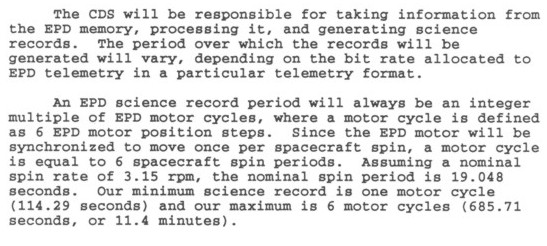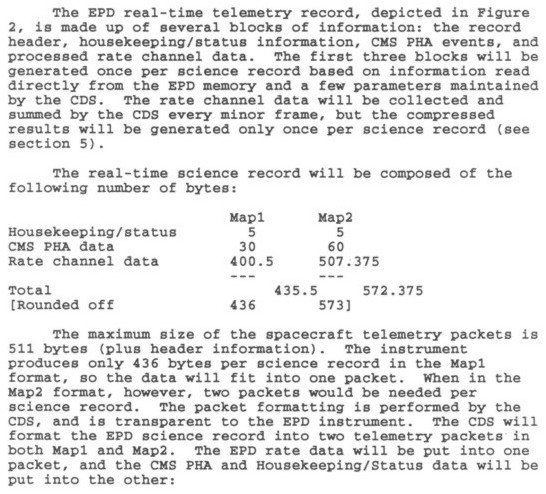The Galileo Energetic Particles Detector
Galileo EPD Handbook
Chapter 2. EPD Software
EPD SBAND Mission Software Requirements (continued)
Source: S. Jaskulek, various dates
CDS-Produced EPD Telemetry Record

Table 12. EPD Science Record Format vs. Format Number
|
Format Number |
Telem. Alloc., bps |
Accum. Period, cycles |
Rate Channels |
Chan. Map |
CMS PHA Events |
Hskpg/ Status, bits |
Telem. Out, bps |
| 1,2,3,4,5 | 5 | 6 | 356 | 1 | 12 | 40 | 5.08 |
| 6,8 | 10 | 3 | 356 | 1 | 12 | 40 | 10.16 |
| 7 | 15 | 2 | 451 | 1 | 12 | 40 | 15.24 |
| 9,10 | 20 | 2 | 451 | 2 | 24 | 40 | 20.03 |
| 11 | 30 | 1 | 356 | 1 | 12 | 40 | 30.48 |
| 12 | 40 | 1 | 451 | 2 | 24 | 40 | 40.07 |

| Packet Type | Data Size | Description |
| Packet 1 | Rate Bin Data | |
| Map1 | 401 bytes | |
| Map2 | 508 " | |
| Packet 2 | CMS PHA and Housekeeping/Status Data | |
| Map1 | 35 bytes | |
| Map2 | 65 " |

RECORD/PLAYBACK SCIENCE PACKET HEADER
Figure 1. EPD2 Record Mode Packet Header
| Field Name | Data Offset | Field Size | Content/Description |
| Time Include Flag | 0 | 1 | =1, 1st packet and every 16th thereafter |
| APID | 1 | 7 | =0A hex |
| Packet Size | 8 | 9 | =76, 152, or 228 |
| Packet Sequence # | 17 | 7 | 0=127 |
| Packet Time | 24 | 32/0 * | R-R-R-mf |
| EPD Minor Frame Data | 56/24 * | 608 | 76-byte EPD Record Packet |
| EPD Minor Frame Data | 664/632 * | 608 | 76-byte EPD Record Packet |
| EPD Minor Frame Data | 1272/1240 * | 608 | 76-byte EPD Record Packet |
* The first number is for time included, the second is for time not included.
Time Included - This bit indicates if the time filed contains information. For the Record Mode data, time is included in the first packet of a new rate and every 16th packet thereafter. For those packets without the time, the packet is shortened by 32 bits.
Application ID - This 7-bit field generated by the CDS for all packets, and is used to identify the source of the data.
Size - This 9-bit field indicates the number of data bytes included in the packet.
Sequential Number - This 7-bit counter is incremented for each new EPD packet created.
Time - This 32-bit value will contain time reference data whenever the "Time Incl." flag is set. The format is "R-R-R-mf." This is the 24 least significant bits of the S/C RIM counter + spacecraft minor frame clock.
EPD2 REAL-TIME SCIENCE PACKET
Figure 2. EPD1 RT Mode Packet Header
| Field Name | Data Offset | Field Size | Content/Description |
| Time Include Flag | 0 | 1 | =1, Always |
| APID | 1 | 7 | =31 hex |
| Packet Size | 8 | 9 | =401 Map 1, Rate Packet =508 Map 2, Rate Packet =35 Map 1, PHA/Hskg Packet =65 Map 2, PHA/Hskg Packet |
| Packet Sequence # | 17 | 7 | 0-127 |
| Format ID | 24 | 4 | 1:5 bps 2:10 pbs 3:15 bps 4:20 bps 5:30 bps 6:40 bps |
| Packet Time | 28 | 28 | 1/2 R-R-R-mf |
| EPD RT Data | 56 | Rate or PHA/Housekeeping Data |
Time Included - This bit indicates if the time filed contains information. For the RT Mode data, time is included in every packet.
Application ID - This 7-bit field generated by the CDS for all packets, and is used to identify the source of the data.
Size - This 9-bit field indicates the number of data bytes included in the packet.
Sequential Number - This 7-bit counter is incremented for each new EPD packet created.
Telemetry Format - This 4-bit field indicates which CDS-EPD data collection mode was used to generate the record.
| 1: 5 bps | 2: 10 bps |
| 3: 15 bps | 4: 20 bps |
| 5: 30 bps | 6: 40 bps |
Time - This 28-bit value will contain time reference data whenever the "Time Incl." flag is set. The format is "1/2 R-R-R-mf." This is a translation of the 28 LSBs of the spacecraft minor frame clock.
Return to Galileo EPD Handbook Table of Contents Page.
Return to main
Galileo Table of Contents Page.
Return to Fundamental
Technologies Home Page.
Updated 8/23/19, Cameron Crane
QUICK FACTS
Mission Duration: Galileo was planned to have a mission duration of around 8 years, but was kept in operation for 13 years, 11 months, and 3 days, until it was destroyed in a controlled impact with Jupiter on September 21, 2003.
Destination: Galileo's destination was Jupiter and its moons, which it orbitted for 7 years, 9 months, and 13 days.



